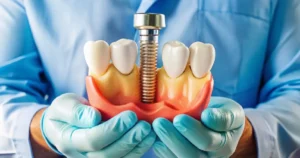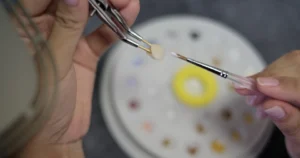Table of Contents
Are you considering dental implants but worried that your jaw might not be strong enough to support them? That’s a common concern—and it’s precisely where bone grafting plays a vital role. If you’re feeling unsure, you’re not alone.
Understanding how bone grafting works in oral surgery in Las Vegas, NV, by Luth & Heideman Center for Dental Care, can make all the difference. We’ll walk you through why it’s often necessary, how it supports successful implants, and what results you can expect—so you can take the next step with clarity and confidence.
What Is Oral Surgery?
Oral surgery is any surgical treatment inside the mouth or jaw, commonly for extractions, implants, jaw realignment, or soft tissue repair. One lesser-known but highly effective procedure is bone grafting, which involves adding bone material to areas of the jaw that have weakened, thinned, or failed to grow fully.
This is especially important when preparing for implants. Implants can loosen or fail over time without enough healthy bone to anchor them. A bone graft rebuilds the jaw’s structure and strength to hold a restoration and function like a natural tooth securely.
How Does Bone Grafting Work
While bone grafting might sound like a significant procedure, it’s often a straightforward and minimally invasive part of a larger treatment plan. It solves a common and critical issue—bone loss- affecting many people after tooth extraction or trauma. Bone grafting oral surgery serves key roles:
- Restores bone density after tooth loss, gum disease, or injury
- Prepares the jaw for dental implants, ensuring stability and longevity
- Preserves facial shape by maintaining bone volume beneath the skin
- Prevents shifting teeth or changes in bite caused by jaw shrinkage
- Improves comfort with dentures by creating a more natural ridge
These are not just cosmetic benefits. Healthy bone structure means a healthier bite, easier chewing, and fewer complications.
Types of Bone Grafts Used
There are several kinds of grafts available. Your oral surgeon will choose the most appropriate type based on your health, bone condition, and treatment goals:
- Autogenous bone graft: Bone is taken from your body, usually from the chin or hip. It’s highly compatible and promotes natural healing.
- Allograft bone graft uses donor tissue, which is carefully sterilized and stored. This avoids the need for a second surgical site.
- Synthetic options: In some cases, bio-compatible materials mimic bone structure.
- Guided bone regeneration: A technique that uses special membranes to guide the formation of new bone exactly where needed.
Each method supports your body’s natural ability to rebuild bone tissue, and your provider will guide you through what’s best for your specific needs.
Who Typically Needs Bone Grafting?
Bone grafting isn’t necessary for every dental implant, but many people require it. It’s often recommended if:
- You’ve lost a tooth, and the extraction site has shrunk over time
- You have untreated periodontal disease that has damaged the jawbone
- You’re missing teeth due to trauma or a congenital issue
- You need a sinus lift before receiving upper jaw implants
- Your jawbone is too narrow or thin to hold an implant safely
If you’ve been told you’re “not a candidate” for dental implants because of bone loss, a bone graft could be the key to making implants possible. This treatment is also suitable for adults of all ages. Whether you’re in your 30s or 70s, the success of a dental bone graft procedure relies more on bone health and your commitment to healing than your age alone.
What to Expect Before, During, and After the Procedure
Understanding the process can ease much of the worry around oral surgery. Here’s how it usually unfolds:
Before the Procedure
Your oral surgeon will take detailed X-rays or 3D scans to assess bone levels. You may be given antibiotics beforehand to reduce infection risk. If you choose sedation, you’ll receive instructions about fasting or arranging a ride home.
During the Surgery
The area is numbed using local anesthesia. A small incision is made in the gum to access the bone site. The graft material is inserted, shaped, and possibly held in place with a collagen membrane. For added precision, guided bone regeneration may encourage your body to rebuild exactly where needed.
The procedure usually takes under an hour for a single site. Many patients opt for light sedation to make the experience more comfortable.
Recovery Timeline
Most patients return to work within 1–2 days. There may be mild swelling, which can be managed with over-the-counter medication and cold compresses. You’ll be advised to stick with soft foods for a few days and maintain good oral hygiene without disturbing the area. Full bone integration takes 3 to 6 months. During this time, your body replaces the graft with natural bone tissue. After healing, you’ll be ready for a secure and lasting dental implant.
Frequently Asked Questions
Is bone grafting painful?
Not usually. The procedure is done under anesthesia, and most patients only experience mild soreness afterward, similar to deep filling or minor dental work.
How long before I can get an implant?
Typically, 3 to 6 months. This allows the new bone to integrate and provide a strong foundation if I don’t get a graft when recommended. Skipping a graft may make implant placement impossible or less stable. In some cases, continued bone loss could make future solutions more complex and costly.
Will insurance help cover it?
Some dental plans help cover oral bone grafting, especially when linked to implant placement. Coverage varies, and the team at Luth & Heideman Center for Dental Care can check your benefits before treatment.
Can the body reject a graft?
Rejection is rare. When properly sterilized material is used and post-op care is followed, bone grafting has a high success rate and low complication risk.
Oral Surgery in Las Vegas, NV
At Luth & Heideman Center for Dental Care, we provide expert, compassionate care for every stage of your oral health journey—from bone grafting to complete implant restoration. Our dentist uses advanced technology and proven techniques to deliver lasting results in a setting designed for your comfort and peace of mind.
Whether you’re just starting to explore your options or ready to move forward, we’re here to guide you with honesty and expertise. Don’t let uncertainty keep you from a stronger, healthier smile. Contact us today!
Glow Up Your Jaw
If you’re considering dental implants or have been told your jaw needs more support, bone grafting may be your next step toward restoring full function and confidence in your smile.
At the Luth & Heideman Center for Dental Care, we offer advanced oral surgery techniques in Las Vegas, NV, designed for comfort, safety, and long-term success. Schedule a bone graft consultation with our oral surgery specialists today!






